Long-path on QSOs and first-call transmissions
Bright copper coils and quickly band-switchin’
Bright paper QSLs from distant kings
These are a few of my favorite things
(From “My Favorite Things” by Rogers and Hammerstein)
My First QSO
Who could forget their first QSO? Maybe we don’t remember every little detail, but for sure that feeling the very first time your call came back from another station is unforgettable. Maybe I should have used Nat King Cole’s classic lyrics instead? Unforgettable, that’s what you are; unforgettable though near or far…
In my case, having learned the code and passed my Novice test, and AT LAST getting my call sign from the FCC in the mail, I rushed back to my friend WNØDYV’s house. Not having a station of my own quite yet, Bill’s folded dipole and HF transceiver were my window to the world. I slowly rapped out a 3-by-3 CQ using one of Bill’s 40 meter crystals and waited…nothing. Another call and then another…nothing. I had begun to think it was never going to work when I finally got an answer! Oh yeah, I have to copy it live off the air!
Sweat rolling down the inside of my shirt, I copied out WB5FXC and nervously began my Ham career. Lynnwood patiently copied my stumbling transmissions with Bill giving me helpful hints like, “Now send your name!” Punctuation—huh? Then all of his information came tumbling back as I struggled to write it down. I received my QSL cards from the Little Print Shop, sent one out (“Mom, can I have a stamp?”), and waited. Then one day, Lynnwood’s bright yellow QSL appeared in the mailbox. I had arrived!
Lynnwood is still an active Ham. I contacted him awhile back to let him know I was still on the air and to thank him for my first, stiff QSO. Many Hams would spend time in the Novice bands making those oh-so-slow QSOs with us as we got ready to take our General exams. It was greatly appreciated. Even a DX station or two would show up, including well-known calls from JA, PY, G, VK, and other countries, mostly in our 15 meter segment. To all of you Novice-workers, thanks!
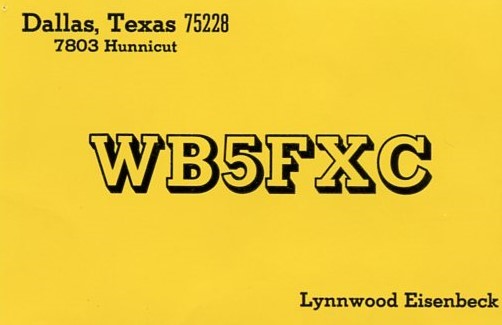
Most Memorable QSO: Lithuania
This was a 1991 QSO I didn’t actually make myself. After a “get on 14.265!” call from a friend, I listened to the most amazing QSO I’d ever heard before—or since. (Call signs are withheld for privacy reasons.) The station on one end was in the radio club at the Lithuanian parliament building, which was surrounded by Soviet tanks. They were talking via 2 meter FM to another station in Vilnius, who then relayed the information to a California station who was acting as the liaison to the U.S. State Department. We got a move-by-move report in real-time of an attempted government overthrow.
As propagation shifted, the link between Lithuania and California became unusable, so a few of us listening in brainstormed and decided one of the big New England contest stations would be better for maintaining extended contact. A call went out (at 2 a.m. Eastern time) and soon the K1 station was on the air with a solid link to Vilnius over the air and a phone line to the State Department. As the hours passed, even that link began to fade, so another Big Gun station—this one an ON4 in Belgium—was put into service, linking Vilnius to New England. Finally, the piece de resistance, literally, was read out as the government of Lithuania was passed into exile over amateur radio. Possibly the most important message ever relayed on the Ham bands. This is why we practice, isn’t it? Unforgettable, indeed!
MS QSO with K1JT
We all have our heroes, especially in amateur radio. One of mine is Joe Taylor, K1JT. A Nobel laureate, to be sure, but an unassuming and personable “Joe” on the air. Having started in Ham radio as a teenager, as had I, Joe went on to become the co-discoverer of a binary pulsar. He measured its spin rate so precisely that he could verify gravitational waves were being radiated at the rate predicted by Einstein fifty years before.
As his formal career concluded (a scientist’s true calling never ends), he recalled his days on the VHF bands with his brother, working scatter modes and laying the groundwork for his life’s work. Maybe that Ham radio stuff would be fun to try again? Applying his expert knowledge of signal processing and encoding techniques, first solo then with a team, Joe went on to create WSJT and then WSJT-X, a family of digital modes and protocols that have taken the amateur world by storm.
So it was an honor for me to participate in the beta testing of FT4, the version of FT8 optimized for rapid-fire QSOs in contests. What worked and what didn’t? Should the mode be asynchronous, depending on the operator to call and respond at the right times? Or synchronous like FT8, with the timing managed by computers? Were the messages sufficient and did the protocol operate like it should? All these questions, and many more, had to be answered. As part of the testing, I scored a QSO with K1JT and the Princeton University station, W2PU, on a mode Joe invented. That’s about as close as I’ll ever get to a Nobel Prize!
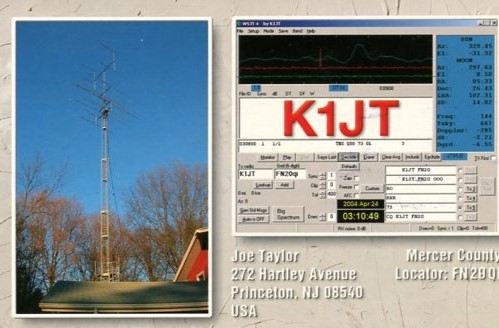
QRP with HZ1HZ and 80 Meters with VKØIR
There are moments in the life of an HF operator when you just “get through” despite all odds, or work them at the last minute. Two such moments stand out for me. I like QRP operating in contests and really enjoy making a QSO in stiff competition.
The big “Sunday Pileups” in a DX contest can really be tough for low-power stations. Everyone knows the hours are fading away and there probably won’t be a second chance when the opening is gone. In my case, Ahmad got on from Saudi Arabia and immediately had a world-class pileup going in the ARRL DX CW contest.
Operating from Seattle at the time, not only did I have a 25 dB power handicap, but I was going to have to fight through all of the stations on the North American continent between me and HZ. With everybody involved, a pileup sometimes gets “out of sync” and there can be opportunities to get through. Sure enough, the pileup slowed and paused, and when Ahmad didn’t transmit, I dumped in a very quick “QRP,” just once. You guessed it, Ahmad sent “QRP? KN” and as I could hear teeth grinding in frustration from Washington to Maine, I quickly put HZ1HZ in the log! The QSL I received is a treasure!
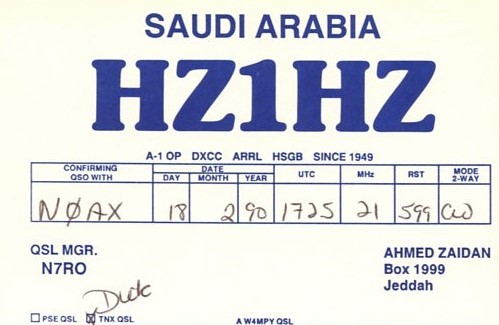
Speaking of treasures, there are few bigger challenges in DXing than really long QSOs on the low bands like 80 and 160 meters. Even the Big Guns come away empty-handed a lot of the time. You have to know the propagation, and, most importantly, you have to be on the air and ready, because you may have only a few seconds when propagation between you and the DX is possible. It’s not enough to wait for the DX station to be spotted! From North America there are few DXCC entities that are more remote and difficult to log than Heard Island, VKØ, positioned in the western Indian Ocean. (No, it isn’t named “Heard” because nobody worked it…). The 1997 expedition, VKØIR, was extremely challenging because of both propagation at the bottom of the sunspot cycle and the rarity of this entity. This resulted in huge, non-stop pileups.
I’d managed to get through on the higher bands, but an 80 meter QSO was going to be really tough. I wasn’t running QRP, but I didn’t have an amp, either, so 100 watts was going to have to be enough. The day passed with my only real shot coming at sunrise. There was only one day left before they were going to start tearing down to come home, so I crossed my fingers and hoped for the best. Sunrise came and went with only occasional snips of signal getting through. Patience, please. I sat at the rig, listening intently as the eastern sky got brighter and brighter—were they getting louder? With the sun peeping over the mountains, I could hear the signal peaking and was finally rewarded with “NØ??” By the slimmest of margins, the op in the island tent (Bob Allphin, K4UEE) stuck with me and, as the band wobbled, finally pulled my whole call through! I think I woke up the entire household celebrating.
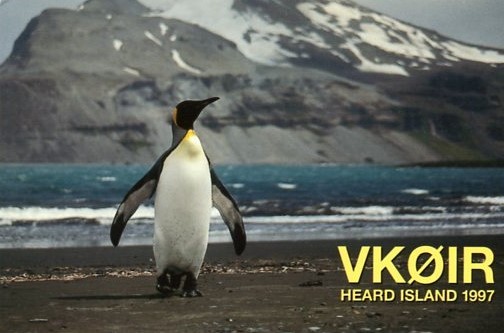
Listening to the World Turn
Speaking of 80 meters at sunrise, there is a phenomenon called the “dawn enhancement” where signals traveling through darkness will increase in strength to the west as sunrise overtakes their location. The increase can be up to 20 dB, but it doesn’t last very long—sometimes much less than a minute. Remember that when you’re hunting the rare ones!
In 2001, I was very fortunate to operate from the big HC8N station in the Galapagos Islands for the CQ WW CW contest. We put up a 2-element wire Yagi for 80 meters between the towers and it needed testing before the contest. Figuring I would work North American stations with ease during the contest, I started calling “CQ EU” at about 0500 UTC, just as sunrise was gliding over the Ural Mountains between European and Asiatic Russia. Sure enough, I started getting answers from weak UA9 and UA4 stations!
The enhancement brought them up so rapidly I could hear them building in strength while they were calling. A quick call sign and RST was enough and then they began to fade. Some sent their power, “25 W 25 W,” in amazement at making an enormously long-distance QSO on a difficult band but just at the right time.
As sunrise moved west, so did my list of call signs. Soon, we were working Moscow and Ukraine, then it was on to eastern Europe and the Baltics, Finland, Poland, and all the rest. Thirty minutes later, the rest of Scandinavia and a host of middle-European DL, I, OK, and Balkan stations were worked. The sun kept rising and the opening moving west, eventually petering out when I worked the last Irish, French, and Spanish stations before dawn splashed into the Atlantic. I took off the phones and five hours had passed. Can you hear the world turning? You bet you can!
A QSO with Myself
How can I make a QSO with myself and why would that be special? Well…if your signal goes all the way around the world and comes back to you, that’s special! Sometimes the bands are just right and a signal can make chordal hops along the ionosphere without a lossy bounce off the ground in between. In addition, at certain times of the year near the equinoxes, the terminator between light and dark goes straight over the poles, as well. This proved to be a potent combination on 15 meters one March day in 1992. Aiming straight north in search of the YA5MM expedition to Afghanistan, I sent a couple of 100-watt “dits” and heard a curious and warbly “ping,” then “ping-ping,” and even “ping-ping-ping” at 1/7th of a second intervals, which is just about how long it takes a radio wave to circle the Earth.
I kept ditting and the signals kept pinging, all with that peculiar “DX sound.” Is this for real? I called a friend nearby and had him listen in to be sure I wasn’t hearing a relay chatter or some other self-generated echo. No, the signals were real! He could hear two and three echoes from my 100 watts. I turned the power down to 5 watts and even got two pings at that power level! We listened in amazement while it lasted, and ten minutes later the echoes were gone. But it was a magic experience. The only question was, “Would I QSL myself?”
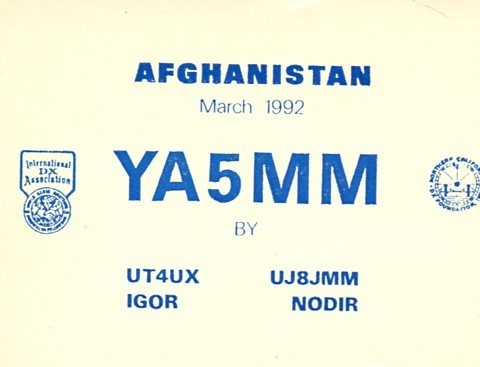
Someone Else’s First QSO
Finally, fancy DX and contest QSOs aside, everybody can be somebody else’s first and most memorable QSO. It is a real treat to learn that I was the numero uno in somebody’s log and launched their Ham careers the way WB5LXC did for me. I make sure to send or answer their QSL card with some extra information or a personal note. That means a lot, and I would be delighted to hear from them years later that they are still active and enjoying Ham radio. Their first QSO could be with you, too!
When the bands die, when the noise sings
When I’m feeling sad
I simply look through my ham radio things
And then I don’t feel so bad

